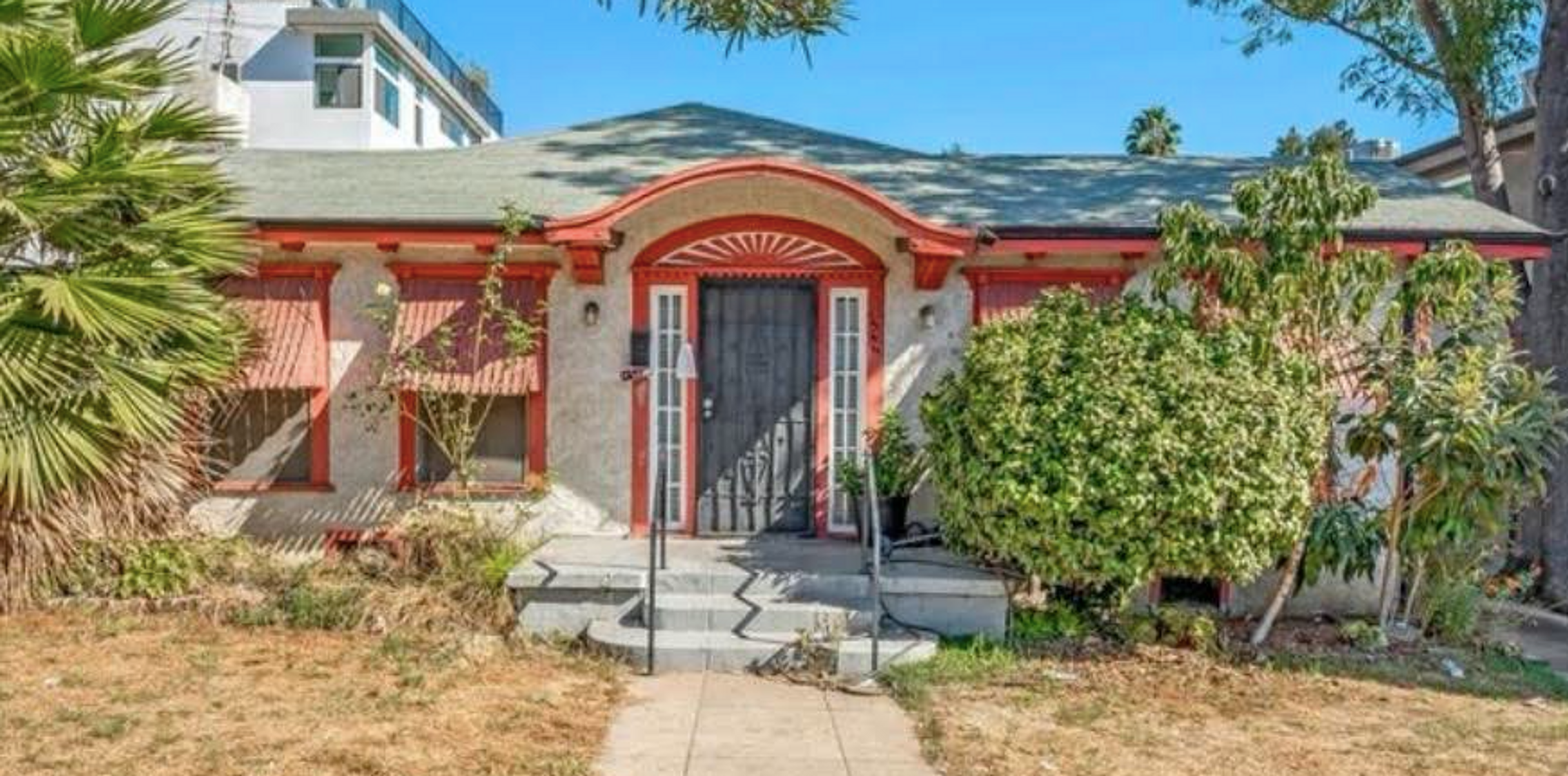On North Fairfax there was this strip of three houses, from (left to right) 1358, 1354, and 1346:
Hey! Down here! I’m 1358! I was built in 1919. I’m kinda storybook!
Hi! I’m 1354! I was also built in 1919! Do I remind you of the French countryside?
Gosh, what’s that noise?
AUUUUGHHhhhhh! hhch… urg…
Which just leaves the one next door to the south at 1346—
Built by George E. Shelton Co. in late 1919, for the actor Jack Mulhall. It’s where Mulhall’s wife committed suicide!
So, were you to demolish this house, Laura Mulhall's ghost would be royally pissed you destroyed her residence of the last 102 years, and will undoubtedly eat your soul.
Oh well! It must go, and developers have no souls to eat anyway!
And, remember that recent development pictured above, which ate up 1346’s cute friends? Three stories? Ha! Sooooo 2019…amateur hour! This is 2023, we’re going to have FOUR stories!
Sure, the area is zoned R-1, but that’s just ZONING LAW. Which means literally, and I do mean literally, less than nothing. Single family zoning, hell—this will be 26 apartments with ZERO ON-SITE PARKING. Yay!
Behold, the forthcoming 1346 North Fairfax:
But wait…it gets better! Three doors down, at 1332 N Fairfax, they’re tearing down ANOTHER little 1919 house to bring you….THE SAME THING.
No, really, they’re going to build two matching boxes, totalling 52 new apartments, with zero parking, and lots of greige.
Oh, and to tear down 1332—
—means tearing down the lifelong home of Mary Philbin. From where she was almost kidnapped in 1925!
Mary Philbin purchased 1332 North Fairfax and lived there the rest of her life (her Wiki page quite incorrectly states she was a recluse in Huntington Beach; and yet Wiki's footnote therefrom links to a source stating she was a recluse for the rest of her life at this house on Fairfax—ah, Wikipedia! so delightfully useless—she died in Huntington Beach because she was put in a rest home near the end of her life, at age 90). Mary’s mother Blanche died in this house in 1934; her father John Philbin died in the house in 1948. Read more about her and her house, here.
But why let a little Hollywood history interfere with the bulldozers and backhoes? YIMBYs hate Hollywood history almost as much as they hate trees! (Well, almost.) The YIMBY hates Hollywood history specifically because it makes Los Angeles special, unique. YIMBYs won't be satisfied until we are one homogenous apartment-scape of perpetual renters in identical beige boxes in Newark, Houston, Youngstown, Jacksonville, Albuquerque, and here in our beloved Los Angeles.
But that's what they want, so that's what we get. Why?
About Nathan Marsak
NATHAN MARSAK says: “I came to praise Los Angeles, not to bury her. And yet developers, City Hall and social reformers work in concert to effect wholesale demolition, removing the human scale of my town, tossing its charm into a landfill. The least I can do is memorialize in real time those places worth noting, as they slide inexorably into memory. In college I studied under Banham. I learned to love Los Angeles via Reyner’s teachings (and came to abjure Mike Davis and his lurid, fanciful, laughably-researched assertions). In grad school I focused on visionary urbanism and technological utopianism—so while some may find the premise of preserving communities so much ill-considered reactionary twaddle, at least I have a background in the other side. Anyway, I moved to Los Angeles, and began to document. I drove about shooting neon signs. I put endless miles across the Plains of Id on the old Packard as part of the 1947project; when Kim Cooper blogged about some bad lunch meat in Compton, I drove down to there to check on the scene of the crime (never via freeway—you can’t really learn Los Angeles unless you study her from the surface streets). But in short order one landmark after another disappeared. Few demolitions are as contentious or high profile as the Ambassador or Parker Center; rather, it is all the little houses and commercial buildings the social engineers are desperate to destroy in the name of the Greater Good. The fabric of our city is woven together by communities and neighborhoods who no longer have a say in their zoning or planning so it’s important to shine a light on these vanishing treasures, now, before the remarkable character of our city is wiped away like a stain from a countertop. (But Nathan, you say, it’s just this one house—no, it isn’t. Principiis obsta, finem respice.) And who knows, one might even be saved. Excelsior!””
Nathan’s blogs are: Bunker Hill Los Angeles, RIP Los Angeles & On Bunker Hill.
